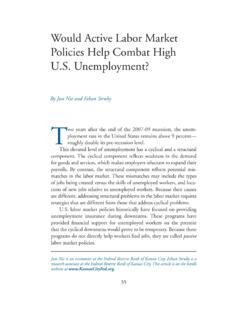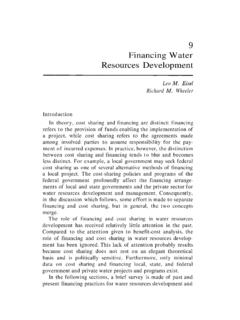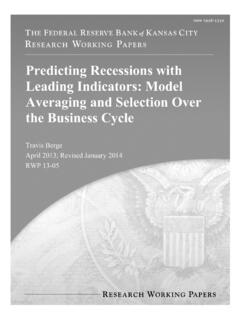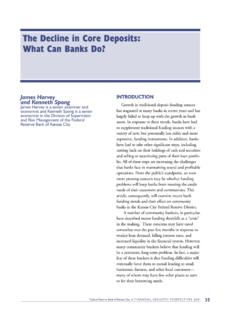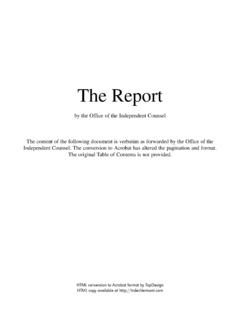Transcription of The Role of Small and Large Businesses in Economic …
1 The Role of Small and Large Businesses in Economic DevelopmentBy Kelly EdmistonIncreasingly, Economic development experts are abandoning traditional approaches to Economic development that rely on recruiting Large enterprises with tax breaks, financial incentives, and other induce-ments. Instead, they are relying on building Businesses from the groundup and supporting the growth of existing enterprises. This approach hastwo complementary features. The first is to develop and support entrepre-neurs and Small Businesses . The second is to expand and improveinfrastructure and to develop or recruit a highly skilled and educatedworkforce. Both efforts depend in Large part on improving the quality oflife in the community and creating an attractive business climate. The reason for the shift in approaches is clear. Experience suggeststhat Economic development strategies aimed at attracting Large firms areunlikely to be successful or successful only at great cost.
2 Smokestackchasing can be especially costly if it generates competition for firmsamong jurisdictions. Further, because of the purported job creation roleand innovative prowess of entrepreneurs and Small Businesses , creatingan environment conducive to many Small Businesses may produce morejobs than trying to lure one or two Large enterprises. The hope is notKelly Edmiston is a senior economist in Community Affairs at the Federal ReserveBank of Kansas City. This article is on the bank s website at RESERVE BANK OF KANSAS CITY only that new Businesses will create jobs in the local community, but,through innovation, some new Businesses may grow into rapid-growth gazelle firms, which may spawn perhaps hundreds of jobs and becomeindustry leaders of tomorrow. This article evaluates this shift in Economic development first section describes traditional Economic development second section explores the role that Small Businesses play in creat-ing jobs.
3 The third section compares job quality between Small firmsand larger firms. The fourth section examines how important smallbusinesses are in the development of new products and new markets. The overarching question is whether promoting entrepreneurshipand Small Businesses makes sense as an Economic development article concludes that it probably does but with some caveats. Smallbusinesses are potent job creators, but so are Large Businesses . The attri-bution of the bulk of net job creation to Small Businesses arises largelyfrom relatively Large job losses at Large firms, not to especially robust jobcreation by Small firms. More importantly, data show that, on average, Large Businesses offer better jobs than Small Businesses , in terms of bothcompensation and stability. Further, there is little convincing evidenceto suggest that Small Businesses have an edge over larger Businesses ininnovation.
4 More research is needed to properly evaluate the case for asmall business strategy, and, indeed, to determine whether or not publicengagement in Economic development itself is a cost-effective andworthwhile WITH TRADITIONAL ECONOMICDEVELOPMENT POLICIESOn the surface, one might think that a Large firm would spur localeconomic growth by yielding significant gains in employment and per-sonal income. The direct effect the jobs and income generated directlyby the firm would certainly suggest this to be the case. In reality,however, it is often the effects on other firms in the area the indirecteffects that carry the greatest weight in the net Economic suggests that because of these typically Large indirect effectsECONOMIC REVIEW SECOND QUARTER 200775and the costs of incentives and competition, Economic developmentstrategies aimed at attracting Large firms are unlikely to be successful orare likely to succeed only at great cost.
5 A recent study of new-firm locations and expansions in Georgiasuggests that, on net, the location of a new Large (300+ employees) firmoften retards the growth of the existing enterprises or discourages theestablishment of enterprises that would otherwise have located there(Edmiston). Specifically, the location of a new plant with 1,000 workers,on average, adds a net of only 285 workers over a five-year period. Thatis, the average firm would add 1,000 workers in its own plant but wouldalso drive away 715 other jobs that would have been generated (orretained) if the new Large firm had chosen not to locate there. Anotherrecent study suggests that the net employment impact of Large -firm loca-tions may actually be closer to zero (Fox and Murray). Much has been made of the indirect effects, or spillovers, of newlarge firms. The positive spillovers include links with suppliers, increasedconsumer spending, the transfer of knowledge from one firm to another,and the sharing of pools of workers.
6 But negative spillovers are impor-tant as well. They include constraints on the supply of labor and otherinputs, upward pressure on wages and rents, congestion of infrastruc-ture, and (if fiscal incentives are provided to the locating firm) budgetpressures from increased spending without commensurate increases inpublic revenues. Even perceptions of these negative effects can driveaway firms, whether or not they actually materialize. The evidence sug-gests that the negative effects dominate with many Large -firm locations(Edmiston; Fox and Murray). Expansions of existing firms, however, tend to have multiplicative pos-itive employment impacts. On average, a plant expansion adding 1,000employees is expected to generate a net employment impact of 2,000. Thisresult supports the notion that internal business generation and growth haspotentially better prospects as a strategy than firm costs per job of incentive packages are generally measured interms of gross new jobs at the new firm.
7 The dollars of incentives aredivided by the number of jobs. During the recruitment stage, these costsare often substantially underestimated. For example, the cost per job76 FEDERAL RESERVE BANK OF KANSAS CITY created for an enterprise creating 1,000 new jobs and offered $20million in incentives is $20,000. But if the net job impact is only 285,the true cost per job created soars to $70,175. In many cases, states or local communities could arguably receivegreater returns by investing the same resources in creating a more con-ducive business environment for existing firms both Large and , recruiting Large firms is often costly, in both direct expendituresand the lost opportunities for other forms of Economic development. Recruitment of Large firms is also costly because it may engender acompetitive Economic development landscape. For example, decisionsby local governments to use tax abatements to lure firms are highlydependent on the decisions of their neighbors (Edmiston and Turnbull).
8 The likelihood that a county uses tax abatements to lure firms increases41 percentage points if its neighbors use them. In other words, a countythat has a 20 percent probability of using tax abatements when none ofits neighbors use them would have a 61 percent probability when all ofits neighbors use them. The presence of a border with a neighboringstate may also encourage the use of tax type of competition can be very costly. Recruiting a firm willgenerate costs for infrastructure, such as roads, sewers, and public serv-ices. If a community gets into a bidding war with another community,fewer resources will be available for absorbing these costs, and neithercommunity gains an advantage by aggressive recruiting. If, for example,one community offers tax incentives to win the new firm, it will faceincreased costs but no property taxes to offset them. The recruitment offirms can therefore be a losing proposition for all most important, from the perspective of society at Large ,aggressive courting of Large firms can distort rational behavior, causing awaste of Economic resources.
9 For example, one region may offer a lowercost option for a newly locating enterprise because of a larger supply oflabor, cheaper costs of transport to market, or other natural advantages. Ifanother region is able to capture the firm away from its optimal locationby offering lucrative financial incentives, resources will be expended need-lessly. For example, shipping the final product over longer distances will bemore expensive. While welfare in the winning region may improve (butnot necessarily), welfare for the larger community encompassing theregion will suffer: Fewer resources would be available for production thanwould be the case if the firm chose its economically optimal REVIEW SECOND QUARTER 200777II. Small Businesses AND JOB CREATIONAn alternative to recruiting Large firms with tax incentives and otherinducements is to focus on the Small business sector.
10 Perhaps the great-est generator of interest in entrepreneurship and Small business is thewidely held belief that Small Businesses in the United States create mostnew jobs. The evidence suggests that Small Businesses indeed create asubstantial majority of net new jobs in an average year. But the widelyreported figures on net job growth obscure the important dynamics ofjob creation and destruction. Nevertheless, Small Businesses remain asignificant source of new jobs in the United States. Net job creationData published by the Census Bureau clearly show that thebulk of net new jobs are generated by firms with less than 20 employees(Chart 1). Netnew jobs are the total of new jobs created by firm startupsand expansions (gross job creation) minus the total number of jobsdestroyed by firm closures and contractions (gross job destruction).


